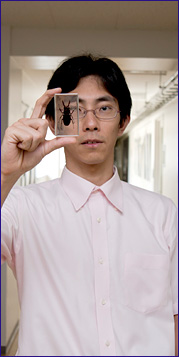



Development of Mathematical Model for Human Evolution
Phenomenal mathematics simply refers to a scholarly pursuit that “logically elucidates various phenomena using mathematics.” In the case of Specially Appointed Associate Professor Joe Yuichiro Wakano, living organisms are his targeted “phenomena,” and he is promoting research along the lines of two main themes. One is to “conduct an observational study of human evolution using mathematical models.” Although it is a matter of course to explain a phenomenon using a mathematical formula in the world of physics, this is still limited in the world of biology. Research into developing mathematical models for the evolution of various living organisms such as insects, plants and livestock has advanced significantly in recent years. However, it is ingrained and well-established among specialists to recognize a “human” target as “something sacred.” Associate Professor Wakano is attempting to take a mathematical and scientific scalpel to the research of human evolution, which has been promoted primarily in anthropology, archeology and other relevant fields. What kinds of evolutionary processes have humans undergone from Australopithecus to becoming Homo sapiens? He is using mathematics for clarification of our initiatives to logically certify the rectitude of the logic of evolution, as the simple accumulation of fossil and other relevant evidence is not sufficient.
Integration of Two Major Theories of Biological Evolution
Another research theme of Associate Professor Wakano is to “build a theory that will integrate the two major theories of biological evolution.” This refers to developing new theories for advancing the development of mathematical modeling for biological evolution in greater detail. The two major theories refer to Inclusive Fitness Theory (IFT) and Adaptive Dynamics Theory (ADT). IFT helped to elucidate the evolution of “cooperative behavior,” which was an issue in Darwinian evolution (why individual organisms such as worker drones exist that do not take on unselfish behavior without leaving offspring, etc.), while ADT is a theory that has significantly helped to clarify “speciation” (such as why evolution into totally different species occurs in the same environment). These two theories make it possible to explain various biological evolutionary phenomena, but mathematics used in each theory also varied, and it was necessary to choose either one theory or the other, depending on the targeted phenomena of research. Nonetheless, in order to understand the evolution more deeply, using one of them was so insufficient that both had to be employed by going back and forth between them. His goal is to mathematically establish an integrated theory for biological evolution by understanding them as a single aspect.
Science is the Desire to “Understand”
His research is promoted by facing phenomena in all cases and employing a style of pursuing fundamentals as a theory. Since such research is different from engineering or studies and does not entail creating something visible, Associate Professor Wakano is sure that many people have difficulty imagining what kind of academic study he is engaged in. However, he says that “science involves a fundamental desire to ‘understand the nature’ of things and is also evidence of being a human, and that this is something deeply related to all aspects of society.” The aims are to understand a phenomenon using mathematic capabilities, project a phenomenon quantitatively and establish a theory. Although it was biology in his case, observational targets in science can be replaced with any others, such as fluctuations of share prices or consumer behaviors. He hopes students strongly “want to learn” about anything that they study. People may dedicate more of their time to philosophical thoughts when they are young. Associate Professor Wakano thinks it is all right for them to feel that they “will elucidate undiscovered principles that no one else knows about.” He has also admired physicists such as Newton since he was a student. Just as Newton discovered the rules about the movement of objects, developed a new tool called differentiation because there were no means of expressing the rules in the mathematical world and completed the original theory as a dynamic equation, he is still very attracted to the concept of creating everything from scratch.
Establishment of the Department Mathematical Modeling, Analysis and Simulation, Graduate School of Advanced Mathematical Sciences in April 2011
Meiji University has newly established the Department of Mathematical Modeling, Analysis and Simulation, Graduate School of Advanced Mathematical Sciences in April 2011 for students who have a desire to elucidate the fundamentals of phenomena. The department will be transferred to
a new campus in Nakano from April 2012. We offer a better research environment for students to acquire knowledge that is necessary for mathematical elucidation of complicated phenomena found in nature, society, living organisms and other relevant matters.
Profile
Specially Appointed Associate Professor of Graduate School of Advanced Mathematical Sciences.
- 1973
- Born in Hyogo prefecture
- 1992
- Graduated from Nada Senior High School
- 1996
- Graduated from Faculty of Science, Kyoto University
- 2001
- Completed the Ph.D. course at the Division of Biological Science, Graduate School of Science, Kyoto University
Ph.D. of Kyoto University (Science)
- 2001-2013
- Engineer at the Department of Chemical System Engineering
- 2003-2006
- Specially approved researcher (21st century COE), Department of Biological Science, Graduate School of Science, The University of Tokyo
- 2006-2007
- Special researcher (PD) (accepted by the aforementioned institute), Japan Society for the Promotion of Science
- 2007–present
- Specially Appointed Associate Professor, Meiji University Organization for the Strategic Coordination of Research and Intellectual Properties
Main Publications and Achievements
“Spatial dynamics of ecological public goods” by Wakano J.Y., Nowak M.A. & Hauert C., Proceedings of the National Academy of Sciences of the United States of America 106:7910-7914 (2009)
Academic Societies
Japanese Society for Mathematical Biology (JSMB), Japan Physical Society (JPS), Japan Society for Industrial and Applied Mathematics (JSIAM), Ecological Society of Japan (ESJ), The Anthropological Society of Nippon (ASN)
Personal website
http://joefs.mind.meiji.ac.jp/~joe/research/index.html











